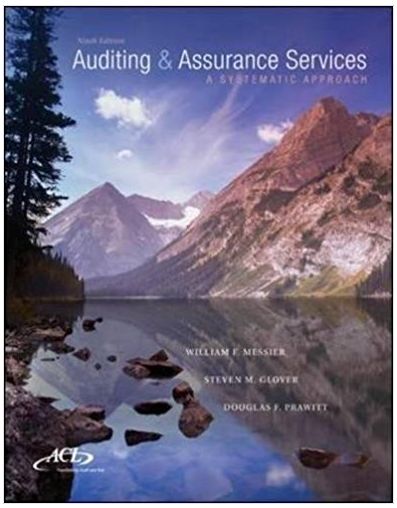Multiple Choice 1. Which of the following questions would an auditor most likely include on a control
Question:
1. Which of the following questions would an auditor most likely include on a control questionnaire for notes payable?
a. Are assets that collateralize notes payable critically needed for the entity’s continued existence?
b. Are two or more authorized signatures required on checks that repay notes payable?
c. Are the proceeds from notes payable used to purchase noncurrent assets?
d. Are direct borrowings on notes payable authorized by the board of directors?
2. An auditor’s primary purpose in examining a letter received from the bank shortly after the balance sheet date that renews and extends an entity’s note payable is most likely to obtain evidence concerning management’s assertions about
a. Existence.
b. Presentation and disclosure- classification.
c. Accuracy.
d. Valuation and allocation.
3. An audit program for long- term debt would most likely include steps that require
a. Comparing the carrying amount of the debt to its year- end market value.
b. Correlating the interest expense recorded for the period with the debt out-standing for the period.
c. Verifying the existence of the holders of the debt by direct confirmation.
d. Inspecting the accounts payable subsidiary ledger for unrecorded long-term debt.
4 An entity has established a bond sinking fund to repurchase a portion of the outstanding bonds each year. The auditor can best verify the entity’s bond sinking fund transactions and year- end bond balance by
a. Confirmation of retired bonds with individual holders.
b. Confirmation with the bond trustee.
c. Recomputation of interest expense, interest payable, and amortization of bond discount or premium.
d. Examination and count of the bonds retired during the year.
5. When an entity does not maintain its own stock records, the auditor should obtain written confirmation from the transfer agent and registrar concerning
a. Restrictions on the payment of dividends.
b. The number of shares issued and outstanding.
c. Guarantees of preferred stock liquidation value.
d. The number of shares subject to agreements to repurchase.
6 The primary responsibility of a bank acting as a registrar of capital stock is to
a. Ascertain that dividends declared do not exceed the statutory amount allowable in the state of incorporation.
b. Account for stock certificates by comparing the total shares outstanding to the total in the shareholders’ subsidiary ledger.
c. Act as an independent third party between the board of directors and outside investors concerning mergers, acquisitions, and the sale of treasury stock.
d. Verify that stock has been issued in accordance with the authorization of the board of directors and the articles of incorporation.
7. To obtain evidence on the authorization assertion, an auditor should trace corporate stock issuances and treasury stock transactions to the
a. Numbered stock certificates.
b. Articles of incorporation.
c. Transfer agent’s records.
d. Minutes of the board of directors.
8. Although the quantity and content of audit working papers vary with each particular engagement, an auditor’s permanent files most likely include
a. Schedules that support the current year’s adjusting entries.
b. Prior years’ accounts receivable confirmations that were classified as exceptions.
c. Documentation indicating that the audit work was adequately planned and supervised.
d. Information regarding the different classes of stock and the number of shares of each class that are authorized to be issued.
9. An auditor compares the current- year revenues and expenses with those of the prior year and investigates all changes exceeding 5 percent. By this procedure, the auditor would be most likely to learn that
a. Fourth- quarter payroll taxes in the current year were not paid.
b. The entity changed its capitalization policy for small tools in the cur-rent year.
c. A current- year increase in property tax rates has not been recognized in the entity’s accrual.
d. The current- year provision for uncollectible accounts is inadequate because of worsening economic conditions.
10. Which of the following comparisons would be most useful to an auditor in evaluating the overall financial results of an entity’s operations?
a. Prior- year accounts payable to current- year accounts payable.
b. Prior- year payroll expense to budgeted current- year payroll expense.
c. Current- year revenue to budgeted current- year revenue.
d. Current- year warranty expense to current- year contingent liabilities.
Contingent liabilities
A contingent liability is an obligation of business related to an uncertain future event. The business must record it in its financial statements if the amount can be reliably estimated and it is probable that amount will be paid by business as a... Accounts Payable
Accounts payable (AP) are bills to be paid as part of the normal course of business.This is a standard accounting term, one of the most common liabilities, which normally appears in the balance sheet listing of liabilities. Businesses receive... Accounts Receivable
Accounts receivables are debts owed to your company, usually from sales on credit. Accounts receivable is business asset, the sum of the money owed to you by customers who haven’t paid.The standard procedure in business-to-business sales is that... Balance Sheet
Balance sheet is a statement of the financial position of a business that list all the assets, liabilities, and owner’s equity and shareholder’s equity at a particular point of time. A balance sheet is also called as a “statement of financial... Liquidation
Liquidation in finance and economics is the process of bringing a business to an end and distributing its assets to claimants. It is an event that usually occurs when a company is insolvent, meaning it cannot pay its obligations when they are due....
Fantastic news! We've Found the answer you've been seeking!
Step by Step Answer:
Related Book For 

Auditing and Assurance Services A Systematic Approach
ISBN: 978-1259162343
9th edition
Authors: William Messier, Steven Glover, Douglas Prawitt
Question Posted:





